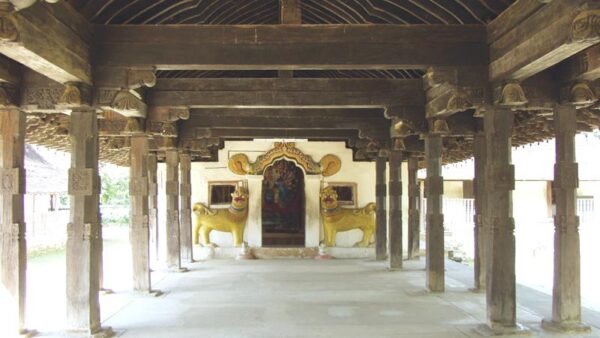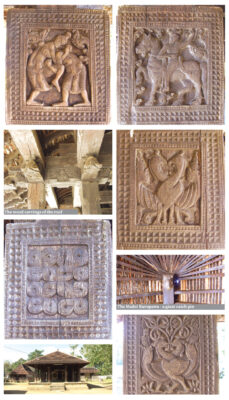Finest example of Sri Lankan architecture- by Mahil Wijesinghe

It was only years later when I was at school that I discovered there was much more to see off the beaten path on the way to Kandy than I had ever been exposed to. One of the most magical and beautifully designed places in the middle of the hinterland was Embekke Devale.
Quiet and serene, I found the temple ground full of peace and beauty. I could not believe that most locals have never visited this place, which has now become an important UNESCO historical site. The location was eight kilometres away from the Peradeniya Botanical Garden and was never on my childhood traveller’s list of places to visit. This rustic temple is a must-visit for anyone, especially, if you are a history buff or a fan of exquisite architectural design. UNESCO has identified the wood carvings on the pillars as the finest to be found in any part of the world.
Three unique temples
 My family and I would take an occasional short trip to Kandy and spend many a morning visiting the three temples along the way. The three unique temples, Gadaladeniya, Lankatilaka and Embekke, were within a few miles of each other, located just outside Kandy. The most famous and my favourite was Embekke because of woodwork.
My family and I would take an occasional short trip to Kandy and spend many a morning visiting the three temples along the way. The three unique temples, Gadaladeniya, Lankatilaka and Embekke, were within a few miles of each other, located just outside Kandy. The most famous and my favourite was Embekke because of woodwork.
It was a common sight to see groups of local students visiting the site. I always wondered why my friends in Colombo never came here on a trip. Maybe they never knew this magical place even existed. However, owning to the Covid-19 pandemic, there were fewer crowds at the temple in March this year when we visited the Embekke Devale.
The Embekke Temple was built in the 14th century as an audience hall for the Kings of Gampola, a city near Kandy. Later, the hall was converted to a temple dedicated to the deity Kataragama, where locals would come and make vows and requests.
According to ancient documents and the epic Embekke Varnanawa, the Devale was built during the Gampola period of King Vickramabahu III (1371 AD). The story goes that one of the king’s beautiful consorts, Henakanda Biso Bandara, in collaboration with a drummer named Rangama, had a miraculous dream in which he built this devale dedicated to the deity Kataragama in a three-storeyed building that is now non-existent. The Devale was built in two segmented buildings, the Digge (Dancing Hall) and Drummers Hall (Hewasi Mandappaya).
Finely carved pillars
The temple is famed for many finely carved pillars depicting majestic birds such as eagles and swans. Each pillar has its own carving. Besides the wildlife carvings, some pillars are carved with wrestling men, dancing women and other human subjects. The wooden load-bearing pillars have assumed varied shapes moulded into these intricate wood carvings. The bottom square is octagonal in shape, with carvings, while its top is expressed in a leaf emanating from the square.
Embekke Devale, nestled in the Udu Nuwara, lies close to Daulagala, about eight miles from Kandy. Embekke Devale is the finest example of Sri Lankan architecture and art showcased in wood. Almost every inch of the wooden structure is decorated with elaborated, intricate carvings on rafters, beam columns, bracket, doorways, doors and windows. Nothing was spared.
The carvings include 125 series of decorations, 256 liyawel, 64 lotus designs on Pekada (brackets), and 30 decorative patterns on timber roof beams, making a total of 514 fabulous carvings.
My favourite masterpieces on these amazing wooden pillars include the Hansa Puttuwa (entwined swans) two-headed eagles, and interwoven rope designs, the mother breastfeeding her child, the soldier fighting on horseback, female dancing figures, wrestlers, elephant-bull combination and the elephant-lion fusion.
Best examples of Sinhalese art
The building on the temple ground called the Drummers Hall has some of the most intricate carvings on the columns. Some carvings at the entrance to the Hall, known as the Vahalkada, are some of the best examples of Sinhalese art in Sri Lanka. Some ancient stories claim that some of the beautiful woodwork in the Drummers Hall was originally in the abandoned Royal Audience Hall in Gampola.
There are other stories about how all the different Sinhala Buddhist Kings repaired the temple dedicated to the Hindu god Kataragama.
The roof of the Drummers Hall has significant features. The rafters all slant from above towards the middle and are fixed together and kept in position by a Madol Kurupawa, a kind of a giant catch pin, which holds together 26 rafters at the hipped end of the roof of the Digge of the Embekke Devale. The Madol Kurupawa is one of the finest examples of medieval carpentry excellence. This kind of spectacular architecture is very rare. I have always been grateful to have discovered this well-kept secret at a young age so that I have been able to share this wonderful place with my family and friends.








